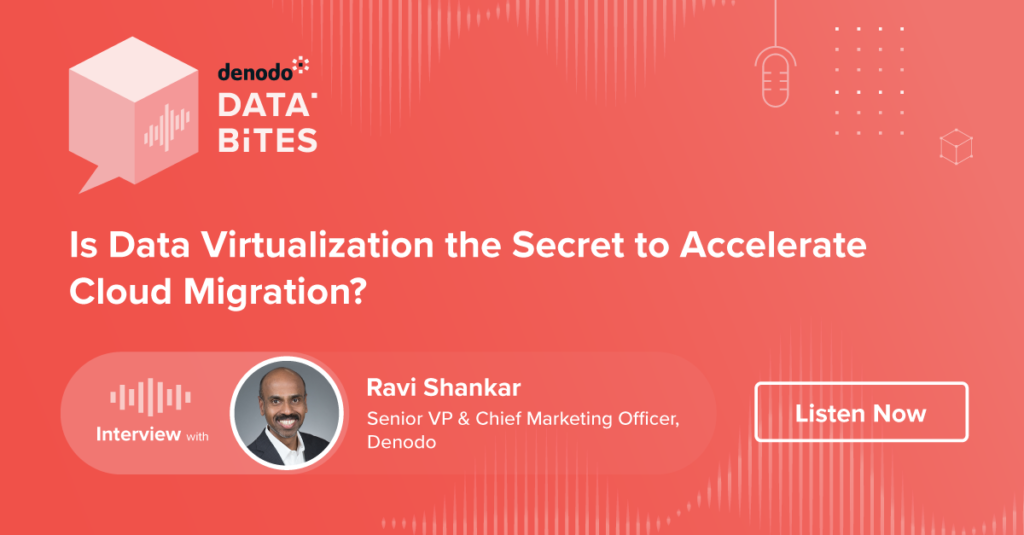
A deep dive into All Things Data with Ravi Shankar, Senior Vice President and Chief Marketing Officer at Denodo, with a special focus on data virtualization as the accelerator of cloud migrations.
Data Virtualization, the Champion
Why is data virtualization the champion, and why is it the secret behind accelerated cloud migrations? Before I answer those questions, I need you to understand that today, there is a tremendous amount of data that is spread out across multiple different systems in geographically dispersed data centers and cloud instances.
Many organizations struggle to gain a unified view over all of their available information and deliver it to business users in real time, in a fashion that meets their needs. Quite often, without data virtualization, they have been relying on legacy data integration technologies to bring the data together, replicating it into a different source, trying to curate it, format it to meet business needs, and deliver it at the moment that it is needed.
This is where data virtualization comes to the rescue. Data virtualization is a real-time data integration and delivery mechanism that is much faster and much less expensive to implement, and it provides access to data in a fraction of the time of traditional approaches.
Cloud Modernization for the Win
Data virtualization is as established as data integration itself. It was used to overcome the challenges faced by traditional data integration methods, such as extract, transform, and load (ETL) processes, the predominant method for loading data into data warehouses. The global cloud modernization effort started about seven or eight years ago, around the time when data stewards started leveraging data virtualization to migrate their legacy data from on-premises data stores to the cloud.
If you look at the Gartner Hype Cycle, you will see that it is made up of a number of different hype cycles. In the one for data management, you would see that data virtualization is positioned all the way to the right of the cycle, which means that it is a mature, stable technology that has reached the “Plateau of Productivity,” in Gartner’s terms. And that means that the technology has been used successfully by thousands of different customers. It has been thoroughly tested, and it works really well.
A Customer Story
Logitech was one of the early adopters of cloud migration simply because the company saw the benefits of shifting from capital to operational expenditure and modernizing the infrastructure. But it was not easy for a company as big as Logitech to migrate all of its data to the cloud, since the company manufactures such a wide variety of different devices and maintains systems that are spread out across multiple different countries and continents.
Data virtualization was Logitech’s go-to technology; it provided an enterprise data layer under which IT teams were able to slowly migrate from their existing on-premises systems to the cloud. This was a huge value-add, since data virtualization enabled migrations in a very flexible manner and protected the business users from any complexities related to consuming the data during this time of change.
Another key benefit was the real-time effect. Source data is now available to business users instantaneously, since the data does not have to be replicated into another system. As the data gets created through the business operations at the source, business users, whether they are at a call center or at a desk performing analytics, can gain access to the fresh data, and that is a big advantage.
A Word about Performance
Some might be skeptical that data virtualization is truly capable of delivering data in real time. Data sources often contain millions or even billions of rows of data. But data virtualization does not usually even attempt to lift all of the data in a given source. It actually tries to run the queries, optimizing the process, and it brings back just the results to the business users.
If we use an analogy, it is like providing a person with a glass of water. Either you can bring the entire pitcher, and then pour the person a cup of water, or you can just go to the pitcher, pour a cup of water, and then just transport the cup. It would be much easier, and much more sensible, to transport just a cup of water rather than the whole pitcher. Data virtualization is like bringing the water in just a cup, as needed. It moves only the minimal data that is actually required by the business users.
Endless Possibilities with Cloud Migration and Data Virtualization
When it comes to cloud migration, I think you can see now that data virtualization is the clear champion, as well as the secret behind every streamlined, accelerated cloud migration process. Data virtualization can help you to get the most out of your data across a wide variety of different uses cases. How would you like to try it out today, with a free, no-risk trial?
- Embracing Data Mesh: A Modern Approach to Data Management - September 21, 2023
- Monolithic vs. Logical Architecture: Which for the Win? - February 16, 2023
- Modern Data Ecosystems that Drive Business Value - January 6, 2023


Really this is great information. Thanks for sharing this with us
Thanks for the great discussion
Data virtualization can be an effective tool for accelerating cloud migrations by simplifying data access and integration across disparate sources. By creating a virtualized layer that abstracts data complexities, data virtualization makes it easier to move data to and from the cloud, reducing costs and improving efficiency. However, it should be used in conjunction with other cloud migration strategies and is not a standalone solution.